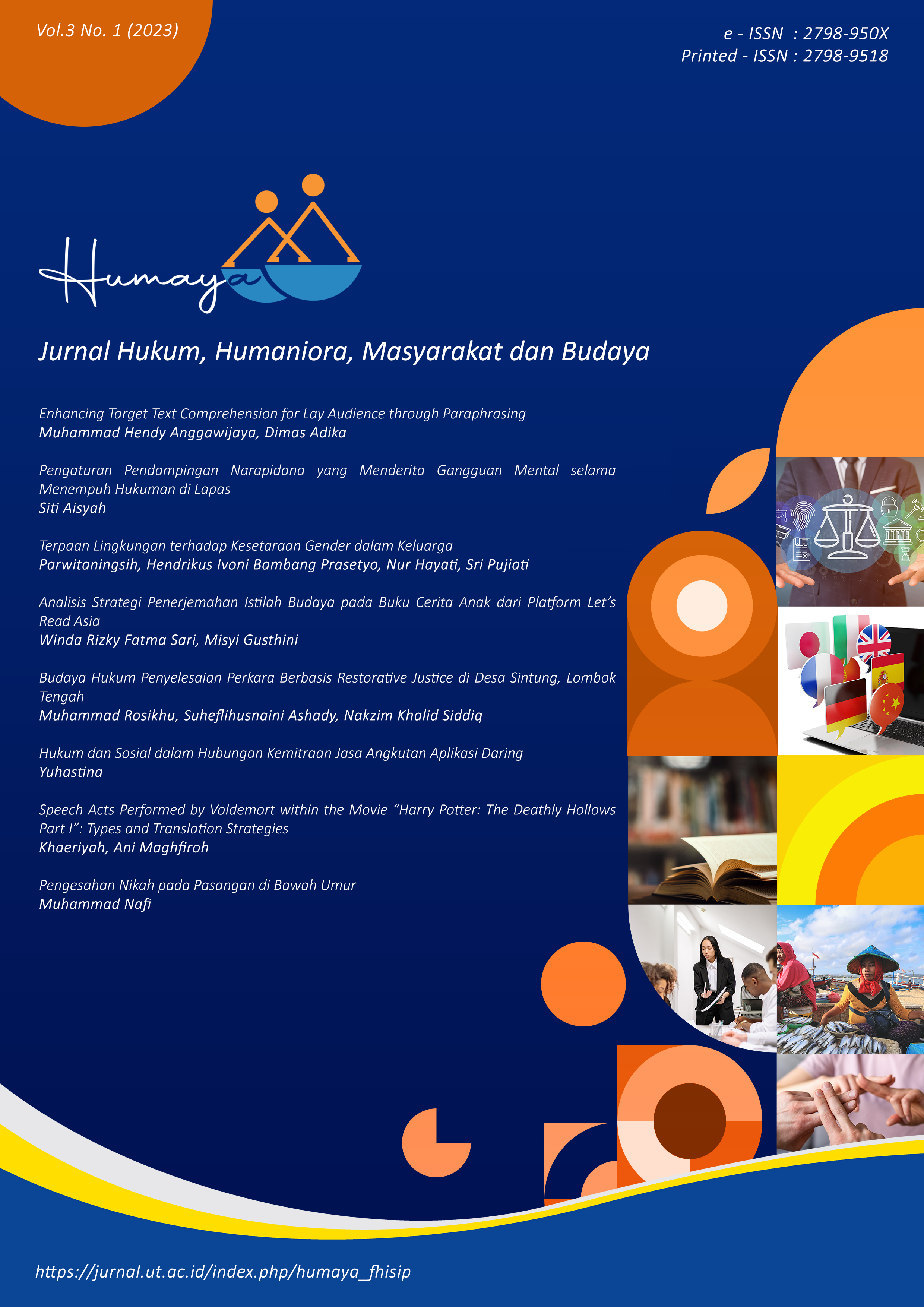Terpaan Lingkungan terhadap Kesetaraan Gender dalam Keluarga
DOI:
https://doi.org/10.33830/humaya.v3i1.4927Keywords:
Gender, Gender equality, Environment influencesAbstract
Gender socialization in the family is intended for children to learn about gender roles. It is the family that begins to teach a boy to adhere to masculine traits and a daughter to adhere to feminine traits. This gender learning process is often influenced by factors outside the family which then have an impact on gender equality. Therefore, research was conducted to examine how the environment influences the implementation of gender equality in the family. This study used a combined approach to collect and analyze quantitative and qualitative data because researchers wanted to see trends in data regarding the influence of the environment on gender equality in the family. The results of the study showed that the environment has a significant influence on the implementation of gender equality in the family. The higher the environmental exposure, the higher tendency of respondents not to implement gender equality. This means that there are still differences between boys and girls related to the type of task, type of toys, type of character, pride, and type of color. Every boy or girl already has their own references that have been determined by the family and influenced by the environment. The neighboring factor becomes the dominant factor, in which respondents are aware of these differences, compared to the mass media, friends, and parents. This implies that neighbors are a factor that has a significant influence on respondents in applying differentiation.
References
Bear, J. H. (2008). What Colors Appeal to Men? The New York Times Company.
Bressler, C. E. (2011). Literary criticism: An Introduction to Theory and Practice (5th ed.). Pearson Education.
Caldera, Y. M., Huston, A. C., & O’Brien, M. (1989). Social Interactions and Play Patterns of Parents and Toddlers with Feminine, Masculine, and Neutral Toys. Child Development, 60(1), 70–76. https://doi.org/10.1111/j.1467-8624.1989.tb02696.x
Cresswell, J. W. (2015). Riset Pendidikan Perencanaan, Pelaksanaan, dan Evaluasi Riset Kualitatif & Kuantitatif (Helly Prajitno Soetjipto & Sri Mulyantini Soetjipto, Trans.; 5th ed.). Pustaka Pelajar.
Dasopang, M. A., & Montessori, M. (2018). Lingkungan dan Kebiasaan Orang Tua sangat Berpengaruh terhadap Perilaku dan Sikap Moral Anak (Studi di Kelurahan Flamboyan Baru Kecamatan Padang Barat RT 01). Journal of Civic Education, 1(2), 98–107. https://doi.org/10.24036/jce.v1i2.198
Eshleman, R. J. (1994). The Family an Introduction (7th ed.). Allyn and Bacon.
Ibrohim, I. (2018). Pembelajaran Responsif Gender pada Pendidikan Anak Usia Dini. Al Aqidah (Jurnal Studi Islam), 1(1), 29–40. http://alaqidah.ac.id/wp-content/uploads/2018/11/Pembelajaran-Responsif-Jender.pdf
Khaerani, S. N. (2017). Kesetaraan dan Ketidakadilan Gender dalam Bidang Ekonomi pada Masyarakat Tradisional Sasak di Desa Bayan Kecamatan Bayan Kabupaten Lombok Utara. Qawwam, 11(1), 59–76. https://doi.org/https://doi.org/10.20414/qawwam.v11i1.723
Kholifah, N. (2019). Pengaruh Pola Asuh Ibu terhadap Tingkat Kesadaran Kesetaraan Gender. Jurnal Psikologi: Jurnal Ilmiah Fakultas Psikologi Universitas Yudharta Pasuruan, 6(2), 81–93. https://jurnal.yudharta.ac.id/v2/index.php/ILMU-PSIKOLOGI/article/view/1817
Kholisoh, N. (2018). Pengaruh Terpaan Informasi Vlog di Media terhadap Sikap Guru dan Dampaknya terhadap Persepsi Siswa. Jurnal Aspikom, 3(5), 1002–1014. https://doi.org/10.24329/aspikom.v3i5.380
Kiram, M. Z. (2020). Pendidikan Berbasis Gender dalam Keluarga Masyarakat Aceh. Community: Pengawas Dinamika Sosial, 6(2), 180–191. https://doi.org/10.35308/jcpds.v6i2.2503
Mappapoleonro, A. M. (2020). Implementasi Gender dalam Pengasuhan Pembelajaran di PAUD Permata Karunia Usia 4-6 Tahun. Yasmin: Jurnal Pendidikan Anak Usia Dini, 1(1), 22–32. http://jurnal.unmuhjember.ac.id/index.php/yasmin/article/view/3219
Musyafirah, M., Andriani, A., & Hapsah, H. (2016). Related Factors of Social Personal Task Achievement of Preschool Children. Indonesian Contemporary Nursing Journal, 31–37. https://doi.org/https://doi.org/10.20956/icon.v1i1.3366
Poloma, M. M. (2004). Sosiologi Kontemporer. PT Raja Grafindo.
Santika, I. G. N., Kartika, I. M., & Wahyuni, N. W. R. (2019). Pendidikan Karakter: Studi Kasus Peran Keluarga terhadap Pembentukan Karakter Anak Ibu Sunah di Tanjung Benoa. Widya Accarya, 10(1), 54–66. http://103.207.99.162/index.php/widyaaccarya/article/view/864
Siregar, D. A. I., & Rochani, S. (2010). Sosialisasi Gender oleh Orang Tua dan Prasangka Gender pada Remaja. Jurnal Psikologi, 3(2), 141–147. https://ejournal.gunadarma.ac.id/index.php/psiko/article/view/230
Soedarwo, V. S. D. (2010). Sosiologi Gender. Universitas Terbuka.
Sunarto, K. (1993). Pengantar Sosiologi. Lembaga Penerbit Fakultas Ekonomi Universitas Indonesia.
Wiguna, I. B. A. A., & Sunariyadi, N. S. (2021). Peran Orang Tua Dalam Penumbuhkembangan Pendidikan Karakter Anak Usia Dini. Widyalaya: Jurnal Ilmu Pendidikan, 1(3), 328–341. http://jurnal.ekadanta.org/index.php/Widyalaya/article/view/126
Downloads
Published
How to Cite
Issue
Section
License
Copyright (c) 2023 Nur Hayati, Parwitaningsih Parwitaningsih, Hendrikus Ivoni Bambang Prasetyo, Sri Pujiati

This work is licensed under a Creative Commons Attribution-ShareAlike 4.0 International License.




